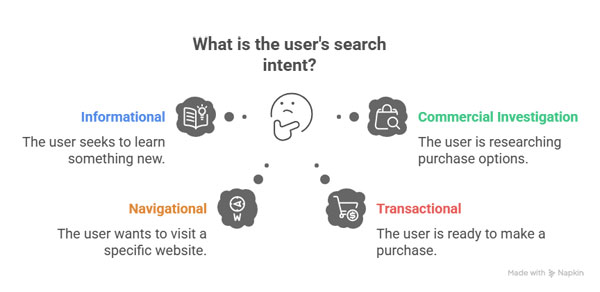We are not all born with journalistic traits. I certainly wasn’t, didn’t even pass English “O” Level at school. But for years, I could write content on my websites, that ranked well. Back in those days, 500 words was deemed to be the standard, then squash some keywords in, then you would be fine. But times have changed, we need to be so much more careful, so let’s look at some of the mistakes you can make at this moment in time, writing content.’
You’ve spent hours crafting what you believe is the perfect blog post. It’s insightful, well-written, and packed with value. You hit “publish” with a sense of accomplishment, expecting the traffic to start rolling in.
But then… crickets.
It’s a frustrating feeling, right? You followed all the classic advice: “Write for people, not for search engines!” And that’s true. But what if I told you that in your quest to write for humans, you might be accidentally making simple mistakes that tell search engines like Google to ignore your fantastic work?
The truth is, modern SEO isn’t about tricking algorithms. It’s about creating an incredible experience for your reader in a way that search engines can easily understand and reward. It’s a partnership, not a battle.
Let’s walk through the most common content writing mistakes that hurt your SEO and, more importantly, how you can easily fix them.
Mistake #1: Ignoring Search Intent (The Cardinal Sin)
This is the big one. The foundation of everything. You can have the best article in the world, but if it doesn’t match what the user is actually looking for, it won’t rank.
What is Search Intent? Simply put, it’s the “why” behind a search query. What goal does the user want to accomplish? Google’s primary mission is to satisfy user intent as quickly and effectively as possible. If your content doesn’t help with that, it won’t be shown.
There are four main types of search intent:
- Informational: The user wants to learn something (e.g., “how to fix a leaky faucet,” “what is SEO”).
- Commercial Investigation: The user is considering a purchase and is researching options (e.g., “best CRM software,” “iPhone vs. Android reviews”).
- Navigational: The user wants to go to a specific website or page (e.g., “Facebook login,” “Netflix”).
- Transactional: The user is ready to buy something (e.g., “buy Nike running shoes,” “subscribe to Spotify Premium”).
The SEO Implication: Google ranks pages that best satisfy the detected intent. If someone searches for “best wireless headphones,” they don’t want a page that’s a direct sales link for a single brand (transactional intent). They want a comparison guide or a list of reviews (commercial investigation).

How to Fix It: Before you write a single word, type your target keyword into Google. Look at the top 10 results. What kind of content are they? Are they listicles? In-depth guides? Product pages? Your content needs to be a better version of what’s already ranking. If the top results are all “how-to” guides, your product page for that term is doomed from the start.
Mistake #2: Keyword Missteps: Stuffing vs. Strategic Use
Remember the old days of the internet, when people would cram keywords everywhere until a paragraph looked like this?
“Our best SEO content writing services provide expert SEO content written by our SEO content writers who understand complex SEO content strategies.”
Yikes. Not only is it horrible to read, but Google’s advanced algorithms, like BERT and now MUM, are designed to understand natural language. Keyword stuffing is a surefire way to make your site look spammy and get penalized.
The modern mistake is often the opposite: avoiding keywords altogether for fear of sounding unnatural.
The SEO Implication: Keywords are still vital. They are the primary signals you send to Google to tell it what your page is about. Avoiding them means you’re not sending any clear signals.
How to Fix It: Use keywords strategically and naturally.
- Primary Keyword: Include it in your title (H1), a subheading (H2), the first 100 words of your content, and naturally throughout the body.
- Synonyms & Related Terms: This is the real secret sauce. Use variations of your keyword and terms that are semantically related. This helps Google understand the context and depth of your content. For a article about “home baking,” you’d also use terms like: “sourdough recipe,” “kneading dough,” “oven temperature,” “baking tips.” Tools like Google’s “People also ask” and “Related searches” are goldmines for this.

Mistake #3: Thin Content That Doesn’t Add Value
“Thin content” is any content that provides little-to-no value to the reader. It’s the stuff that makes you click the back button immediately. This could be:
- Very short, unsubstantial pages.
- Content that merely aggregates snippets from other sources without adding original commentary.
- Doorway pages that are created solely to rank for specific queries.
Google’s Panda algorithm update was specifically designed to target and demote thin content in search results. The goal is to reward pages that demonstrate E-E-A-T: Experience, Expertise, Authoritativeness, and Trustworthiness.
The SEO Implication: Websites filled with thin content are seen as low-quality and are unlikely to rank well. They have high bounce rates (people leaving quickly) and low dwell time (how long people stay), which are negative ranking signals.
How to Fix It: Don’t just write more; write better. The concept of “Topic Clusters” is powerful here. Instead of writing 50 short, separate articles, create one definitive, pillar page on a broad topic (e.g., “The Ultimate Guide to Content Marketing”) and then support it with more specific cluster blog posts (e.g., “How to Write a Blog Post,” “What is SEO Copywriting?,” “Social Media Content Tips”) that all link back to the main pillar page. This creates a network of deep, valuable content that Google loves.
Mistake #4: Forgetting the Reader Experience (UX)
SEO isn’t just about words on a page. It’s about the entire experience a user has when they land on your site. If your content is difficult to read or navigate, people will leave, and Google will notice.
The SEO Implication: Core Web Vitals are a set of metrics Google uses to measure real-world user experience, focusing on loading, interactivity, and visual stability. A poor user experience leads to poor engagement metrics, which tells Google your page isn’t a good result.
Let’s look at two critical, often-overlooked UX factors:
| Writing for UX: Good vs. Bad | |
|---|---|
| ✅ Good Practice | ❌ Bad Practice |
| Short paragraphs and sentences. Easy to scan. | Giant walls of text that are intimidating. |
| Clear, descriptive subheadings (H2s, H3s). | Vague or missing subheadings. |
| Bullet points and numbered lists to break up info. | No visual breakpoints in the content. |
| Relevant images, infographics, or videos. | Large blocks of text with no media. |
| Loads quickly on mobile and desktop. | Slow loading times, especially on mobile. |
How to Fix It: Format your content for humans! Use subheadings, bullet points, and images. Break up long paragraphs. Most importantly, ensure your site is mobile-friendly and loads quickly. Tools like Google’s PageSpeed Insights can give you a report card on your site’s performance.
Mistake #5: Neglecting Internal Linking
Internal links are the hyperlinks that connect one page on your website to another. They’re like building pathways throughout your own content library.
Many writers finish an article and call it a day, forgetting this crucial step.
The SEO Implication: Internal links help Google’s bots discover new pages on your site and understand the architecture and hierarchy of your content (which pages are most important). They also help distribute “link equity” or ranking power from your strong pages to newer or less-established pages. Perhaps most importantly, they keep users on your site longer by guiding them to other relevant content.
How to Fix It: When you publish a new article, spend 10 minutes asking: “What existing content on my site is relevant to this new post?” Then, naturally within the body of your new text, link 3-5 relevant anchor phrases (e.g., “as we discussed in our guide to keyword research”) to your older articles. Avoid using “click here” as anchor text. Be descriptive.
Bringing It All Together: Write for People, Optimize for Engines
The dynamic between content writing and SEO isn’t complicated once you understand the goal: to be the best, most helpful answer to a searcher’s query.
The mistakes we covered all stem from forgetting one half of that equation. You’re either writing something that isn’t helpful (ignoring intent, thin content) or you’re creating something helpful but not making it easy for Google to see that it’s helpful (ignoring keywords, UX, and internal links).
The best content marketers and writers in the world weave SEO fundamentals into the fabric of their writing process. They research intent first, they structure their content for clarity, and they ensure it’s a pleasure to read. The optimization isn’t an afterthought; it’s part of the craft.
So, the next time you sit down to write, don’t see SEO as a set of restrictive rules. See it as a framework for being understood—by both your audience and the algorithms that connect you to them.
Now, go check your last few blog posts. Are you guilty of any of these mistakes? The good news is, every single one of them is fixable. Happy writing (and optimizing
